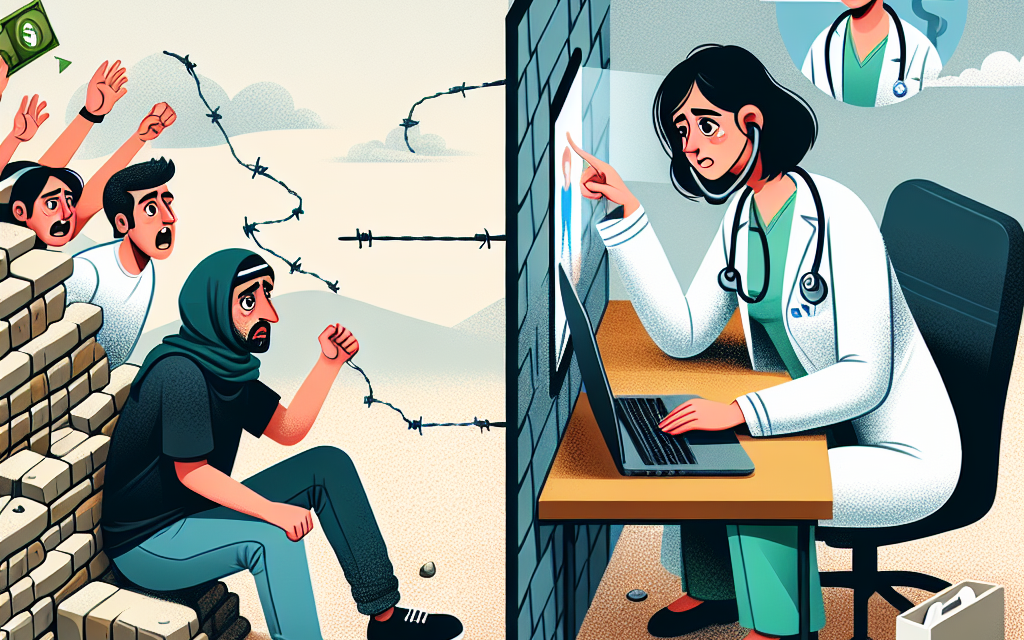The Rise of Telemedicine: Breaking Barriers in Healthcare Access
Telemedicine, also known as telehealth, is a rapidly growing field in healthcare that is changing the way patients receive medical care. With the advancement of technology, telemedicine has become a viable option for patients to access healthcare services remotely, breaking barriers in traditional healthcare access. This innovative approach to patient care has the potential to revolutionize the healthcare industry and improve the overall patient experience.
One of the main barriers that telemedicine is breaking is the issue of geographical distance. In traditional healthcare, patients living in rural or remote areas often face challenges in accessing quality healthcare services due to the lack of healthcare facilities in their vicinity. This can result in delayed or inadequate treatment, leading to poorer health outcomes. However, with telemedicine, patients can now connect with healthcare providers from the comfort of their own homes, regardless of their location. This has opened up a whole new world of possibilities for patients who previously had limited access to healthcare services.
Moreover, telemedicine has also broken barriers for patients with mobility issues or disabilities. For individuals who are unable to leave their homes due to physical limitations, telemedicine provides a convenient and accessible way to receive medical care. This has not only improved their access to healthcare but also increased their independence and quality of life. Telemedicine has also been a game-changer for elderly patients who may have difficulty traveling to healthcare facilities. With telemedicine, they can now receive medical care without having to leave their homes, making it a more comfortable and less stressful experience for them.
Another significant barrier that telemedicine is breaking is the issue of time constraints. In traditional healthcare, patients often have to take time off work or school to attend medical appointments, which can be inconvenient and disruptive to their daily lives. However, with telemedicine, patients can schedule appointments at a time that is convenient for them, eliminating the need to take time off. This has not only made healthcare more accessible but also more efficient, as patients can receive medical care without disrupting their daily routines.
Furthermore, telemedicine has also broken barriers for patients with limited financial resources. In traditional healthcare, patients may have to incur additional costs such as transportation and childcare to attend medical appointments. This can be a significant burden for individuals and families who are already struggling financially. With telemedicine, patients can save on these additional costs as they can receive medical care from their homes. This has made healthcare more affordable and accessible for those who may have previously been unable to seek medical treatment due to financial constraints.
In addition to breaking barriers in healthcare access, telemedicine has also revolutionized the way healthcare providers deliver medical care. With telemedicine, healthcare providers can now reach a larger patient population, including those in remote or underserved areas. This has not only increased their reach but also improved their efficiency and productivity. Telemedicine has also allowed for better collaboration and communication among healthcare providers, leading to more coordinated and comprehensive patient care.
In conclusion, telemedicine is breaking barriers in healthcare access and revolutionizing patient care. With its ability to overcome geographical distance, mobility issues, time constraints, and financial limitations, telemedicine has made healthcare more accessible, efficient, and affordable for patients. It has also transformed the way healthcare providers deliver medical care, leading to improved patient outcomes. As technology continues to advance, the potential for telemedicine to further break barriers and improve the overall patient experience is limitless.
Breaking Barriers in Mental Health Care: The Impact of Telemedicine

Telemedicine, also known as telehealth, is a rapidly growing field in healthcare that utilizes technology to provide remote medical services. While it has been around for decades, the recent advancements in technology have made telemedicine more accessible and efficient than ever before. This has led to a significant impact on patient care, particularly in the field of mental health.
Mental health care has long been plagued by barriers such as stigma, lack of access to care, and limited resources. These barriers have prevented many individuals from seeking the help they need, leading to a significant gap in mental health treatment. However, telemedicine is breaking down these barriers and revolutionizing the way mental health care is delivered.
One of the most significant barriers in mental health care is the stigma surrounding mental illness. Many individuals are hesitant to seek help due to the fear of being judged or labeled as “crazy.” This stigma has been perpetuated by society for far too long, making it challenging for individuals to open up about their struggles and seek treatment. However, with telemedicine, patients can receive care from the comfort and privacy of their own homes, eliminating the fear of being judged by others.
Moreover, telemedicine has also addressed the issue of access to care. In many rural and underserved areas, there is a shortage of mental health professionals, making it challenging for individuals to receive timely and adequate treatment. With telemedicine, patients can connect with mental health providers from anywhere, regardless of their geographical location. This has not only increased access to care but has also reduced the burden on mental health professionals in urban areas.
Another significant barrier in mental health care is the limited resources available. Mental health facilities are often overcrowded, and patients may have to wait weeks or even months to see a mental health professional. This delay in treatment can have severe consequences, especially for individuals with severe mental illnesses. However, with telemedicine, patients can receive timely care, reducing the risk of their condition worsening.
Furthermore, telemedicine has also made mental health care more convenient for patients. Many individuals may have difficulty attending in-person appointments due to work, family responsibilities, or transportation issues. With telemedicine, patients can schedule appointments at a time that is convenient for them, eliminating the need to take time off work or arrange for transportation. This has made it easier for individuals to prioritize their mental health and seek the help they need.
In addition to breaking down barriers, telemedicine has also improved the quality of mental health care. With the use of video conferencing, mental health professionals can conduct virtual therapy sessions that are just as effective as in-person sessions. This has allowed for more frequent and consistent therapy sessions, leading to better outcomes for patients. Moreover, telemedicine has also made it easier for mental health professionals to collaborate and consult with each other, resulting in more comprehensive and personalized treatment plans for patients.
However, like any other form of healthcare, telemedicine also has its limitations. It may not be suitable for all patients, especially those with severe mental illnesses or those who require in-person care. Additionally, not everyone has access to the necessary technology or internet connection for telemedicine appointments. Therefore, it is essential to have a combination of in-person and virtual care options to cater to the diverse needs of patients.
In conclusion, telemedicine is breaking barriers in mental health care and revolutionizing the way patients receive treatment. It has addressed issues such as stigma, access to care, and limited resources, making mental health care more accessible, convenient, and effective. As technology continues to advance, the potential for telemedicine in mental health care is limitless, and it is undoubtedly a game-changer in the field of healthcare.
Telemedicine and Rural Communities: Overcoming Geographic Barriers to Quality Care
Telemedicine, the use of technology to provide remote medical care, has been gaining traction in recent years as a way to improve access to healthcare for individuals living in rural communities. With the rise of telecommunication and advancements in technology, telemedicine has become a viable solution to overcome the geographic barriers that have long hindered quality care for those living in rural areas.
Rural communities often face unique challenges when it comes to accessing healthcare. The lack of healthcare facilities and providers in these areas can result in long travel times and high costs for patients seeking medical attention. This can be especially problematic for individuals with chronic conditions who require frequent check-ups and treatments. Telemedicine offers a solution to these challenges by bringing healthcare directly to the patient’s doorstep.
One of the main benefits of telemedicine for rural communities is the ability to connect patients with specialists who may not be available in their local area. This is particularly important for individuals with complex medical conditions that require specialized care. With telemedicine, patients can consult with specialists from the comfort of their own homes, eliminating the need for long and costly trips to urban areas.
Moreover, telemedicine also allows for better coordination of care between healthcare providers. In rural areas, patients may have to visit multiple healthcare facilities for different services, which can lead to fragmented care and potential gaps in treatment. With telemedicine, all healthcare providers involved in a patient’s care can communicate and collaborate in real-time, ensuring a more comprehensive and coordinated approach to treatment.
Another significant advantage of telemedicine for rural communities is the potential for cost savings. As mentioned earlier, patients in rural areas often have to travel long distances to access healthcare, resulting in high transportation costs. With telemedicine, patients can save on these expenses and also avoid the loss of income due to time off work for medical appointments. Additionally, telemedicine can reduce the need for hospitalizations and emergency room visits, which can be costly for patients and healthcare systems alike.
Telemedicine also has the potential to improve health outcomes for individuals living in rural communities. With easier access to healthcare, patients can receive timely and appropriate treatment, leading to better management of chronic conditions and overall improved health. This is particularly crucial for rural communities, where there may be a higher prevalence of chronic diseases due to factors such as limited access to healthy food options and physical activity opportunities.
However, despite its many benefits, telemedicine still faces some challenges in rural communities. One of the main barriers is the lack of reliable internet access in some areas. Without a stable internet connection, telemedicine consultations and remote monitoring of patients’ health may not be possible. This issue is being addressed through initiatives such as the Federal Communications Commission’s Rural Health Care Program, which provides funding for broadband services in rural healthcare facilities.
Another challenge is the need for proper training and education for healthcare providers and patients on how to effectively use telemedicine technology. This is especially important for older patients who may not be as familiar with technology. Healthcare providers also need to be trained on how to conduct virtual consultations and examinations to ensure the same level of quality care as in-person visits.
In conclusion, telemedicine has the potential to revolutionize patient care in rural communities by overcoming geographic barriers and improving access to quality healthcare. With advancements in technology and initiatives to address challenges, telemedicine is becoming an increasingly viable solution for individuals living in rural areas. As we continue to see the benefits of telemedicine, it is essential to continue investing in this technology to ensure that all individuals, regardless of their location, have access to the healthcare they need.





